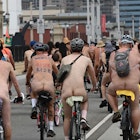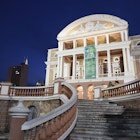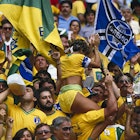The sporting world, with its heroes and symbols, is a massive travel draw. While major international events dominate world headlines, it's often the national competitions that fuel the most passion. Here is an all-too-short list of events that have transcended their games, helping to fashion and define local character and culture:
Football (soccer), South America
Image by timsnell
The national passion in every South American country, nothing unites South Americans more than football. Brazil carries the record for the winning the most World Cup finals, and Brazilian fans are not shy of showing their support – beating drums, singing and dancing in the stalls. One of football’s legends is Brazilian-born Edson Arantes Nascimento (Pelé). The annual championship is the Copa Libertadores: a continent-wide competition played in odd-numbered years.
Big-wave surfing, Hawai’i
Image by Steven | Alan
Hawai’i lies smack in the path of all major swells that surge across the Pacific. Even in ancient times, when the waves were up, everyone in Hawai’i was out in the water. Today, winter swells can bring in immense 10m (30ft) waves and create conditions in which legends are made. O'ahu especially is notorious for its powerful waves. Mother Nature’s colossal surf commands respect, and tackling these waves demands a fair share of skill and gumption.
Australian Football League (AFL) Grand Final, Australia
Image by jimmyharris
Melbourne turns to mayhem for that one day in September when the two top sides slug it out for the Australian Rules premiership. The nation’s most-watched sport (invented to keep cricket players fit in the off-season) was given the go-ahead in 1858 by the then dominant cricket faculty. The final is fought on the hallowed turf of the Melbourne Cricket Ground (MCG) from where every seemingly curious move, play and umpiring decision is televised around the globe.
Formula One Grand Prix, Monaco
Image by briandeadly
The excitement level of the world’s most important professional motor race is heightened in picturesque Monte Carlo, where spectators stand extremely close to the action. The 263km (163mi), 78-lap circuit holds many twists and turns and is deemed the world’s most challenging course. Spectators line the streets to watch the machines whiz by, hear the screaming engines and smell burnt rubber. They first started their engines for the Monaco Formula One Grand Prix in 1929 reaching speeds of 80km/h (50mph); recent speeds clock 142km/h (88mph).
Thai Boxing, Thailand
Image by Willy_G91
High kicks and high jinks are all part of the Thai boxing (muay thai) spectacle, with wild musical accompaniment to the ceremonial beginning of each match and frenzied betting throughout the stadium. Bouts are limited to five three-minute rounds separated with two-minute breaks. Common blows include high kicks to the neck, elbow thrusts to the face and head, knee hooks to the ribs and low crescent kicks to the calf. Early accounts of Thai boxing date to the 15th century where it was used in warfare between Myanmar (Burma) and Thailand.
Tour de France, France
In July the world’s most prestigious bicycle race brings together 189 of the world’s top male cyclists (21 teams of nine) and 15 million spectators for a spectacular 3000km-plus (1860-mile) cycle around the country. The three-week route changes each year, but always labours through the Alps and Pyrenees and finishes on the Champs Élysées in Paris. French journalist and cyclist Henri Desgranges came up with the Tour de France in 1903 as a means of promoting his sports newspaper L’Auto (today’s L’Équipe). With the exception of two world war–induced intervals, it has been held every year since.
Beach Volleyball, Brazil
Image by andybullock77
Buff men in bathing suits and babes in bikinis playing volleyball became a regular sight on the beaches of Ipanema and Copacabana in the heady ’80s. It’s little wonder the sport enjoyed a meteoric rise in popularity after debuting as an official Olympic sport at the 1996 Atlanta Games – where the Brazilian women won gold and silver. The first international beach volleyball exhibition was held in Rio de Janeiro in 1986, with 5000 spectators privy to the sport’s signature dinks, digs and dives.
Super Bowl, USA
America’s National Football League (NFL) championship, the Super Bowl, is the pinnacle of American football. It’s played at a different stadium each year, with no NFL team ever having played on its home turf. It's held on the last Sunday in January or the first Sunday in February, and 60% of America’s televisions tune in to the event. Because of this, the telecast is also known for extravagantly expensive high-concept advertising.
Ascot Races, England
Image by Steve & Jemma Copley
The first incarnation of the Royal Ascot races emerged with a four-day horse race in 1768. This grew into the internationally renowned five-day event we know today: a flurry of jockeys in silk, elegant horses, hats, frocks and suits. The Royal Procession tradition began in 1825 when the king and four other coaches carrying royalty drove up the centre of the racecourse.
This list came from a previous edition of our adrenaline-inspiring Best in Travel guide.



















